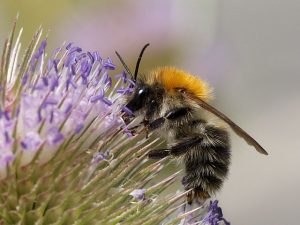There is a lot of missing data on insects in Norway. This data gap makes it hard to know how stable populations of pollinators actually are. In order to detect any possible decreases, we need to map species and monitor any changes in population densities and diversity. By joining this project, you will be contributing with exactly this, which is incredibly important work!
 Project description
Project description
As a consequence of changed land use, most of our coastal heathlands have disappeared. Today, only 10% is preserved. This will probably also have consequences for the pollinator fauna. Pollinators pollinate plants by carrying pollen to the female parts of the flower. In Norway, insects, including bumblebees, bees and hoverflies, perform this service. In return, they get nectar, a rich source of energy and protein-rich pollen grains for their young. These insects are essential for producing many crops that we depend on.
In this project, we will study and compare pollinators at different study sites in Austrheim. Here we distinguish between heathlands that are in good condition, heathland that are becoming overgrown and heathlands that have become overgrown. We will also examine the vulnerability status of the species we find, and look for indicator species that are associated with heathlands. This project will serve as a framework for future analysis, which will make it possible to monitor populations. Our findings will also be compared with a previous study from 1981 “Plants, plant communities and animals on an experimental field with nearby surroundings on Rebnor, Austrheim county, Hordaland”, which was part of the Lindås project.
Tasks
The student will mainly be on lab to key bees, bumblebees and hoverflies from August or September. The student may also be able to join fieldwork to collect pollinators for the study during the summer 2022.
Unfortunately, the project does not have funds to cover accommodation for students who want to join field. But, if the student can get to Austrheim and back they are more than welcome to join. The first 3 weeks of field will be from 30th of may to the 17th of june, excluding weekends. There will also be another 3 week periode in late summer, but the date is not yet decided.
 The project involves: Labwork & Fieldwork
The project involves: Labwork & Fieldwork
Starting date/period: May 30th – December 1st 2022.
Experience: The student will learn how to key and pin pollinators of different taxonomic groups.
The student will learn the importance of collecting data in science and contribute to this data.
The student may learn how to collect and preserve pollinators in field.
Involvement: As much as he or she wants, also depending on how many people want to join (max 40h).
Interested by this project? Need more info? Contact Susanne Zazzera (sza009@uib.no)
Project number: 040
